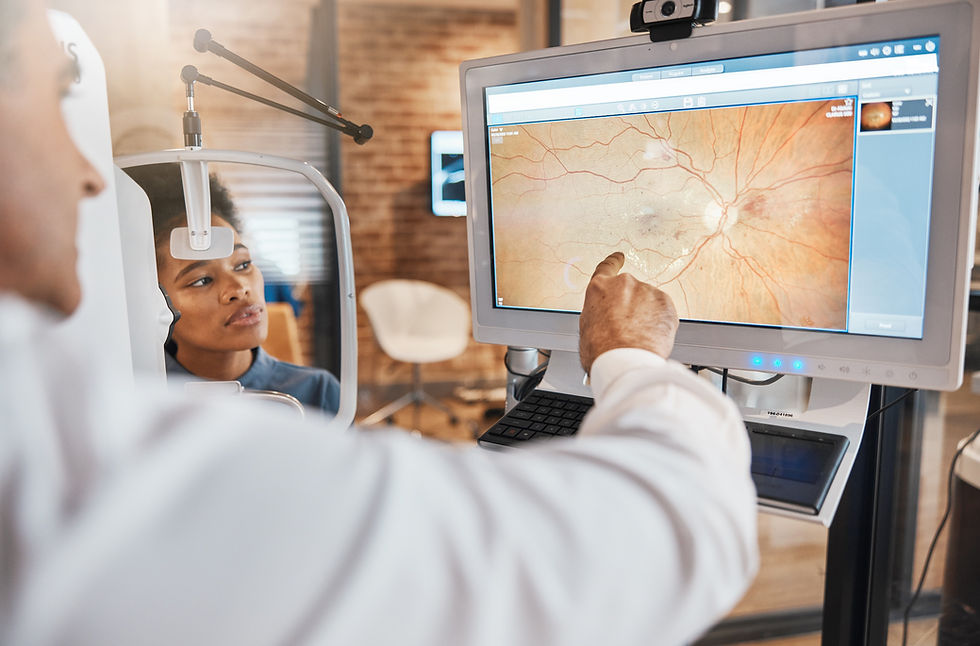
The month of February is Age-related macular degeneration (AMD) Awareness Month. Let's delve into this progressive eye condition that affects millions of people worldwide, particularly those over the age of 50. As one of the leading causes of vision loss in adults, AMD gradually destroys the central vision essential for tasks like reading, driving, and recognising faces. Despite its prevalence, AMD often flies under the radar, overshadowed by more well-known eye conditions like cataracts and glaucoma.
Understanding AMD:
The macula, located at the center of the retina, is responsible for sharp, central vision. AMD damages this crucial part of the eye, leading to blurriness or blind spots in the central vision while leaving peripheral vision intact. There are two main types of AMD: dry AMD and wet AMD.

Dry AMD (Non-neovascular AMD): This form is more common, accounting for about 80-90% of all AMD cases. It occurs when small yellow deposits called drusen accumulate under the macula, leading to its deterioration over time. Dry AMD typically progresses slowly and may cause gradual vision loss.
Wet AMD (Neovascular AMD): Although less common, wet AMD is more severe and progresses rapidly. It involves the growth of abnormal blood vessels beneath the macula, which leak fluid and blood, causing rapid damage to the macula and leading to more sudden and severe vision loss.
Video courtesy of American Academy of Ophthalmology: https://www.aao.org
Risk Factors:
Several factors contribute to the development and progression of AMD:
Age: As the name suggests, age is the most significant risk factor for AMD. The condition primarily affects individuals over 50, with the risk increasing with advancing age.
Genetics: Family history plays a significant role in AMD risk. Individuals with a family history of the condition are at a higher risk of developing it themselves.
Smoking: Smoking is a modifiable risk factor strongly associated with an increased risk of AMD. Quitting smoking can significantly reduce this risk.
Obesity: Being overweight or obese increases the risk of AMD, highlighting the importance of maintaining a healthy weight.
Cardiovascular Health: Conditions like hypertension and high cholesterol levels are linked to an elevated risk of AMD. Maintaining heart health through regular exercise and a balanced diet can help reduce this risk.
Management and Treatment:
While there is currently no cure for AMD, various treatment options and management strategies can help slow its progression and manage its symptoms:
Lifestyle Modifications: Adopting a healthy lifestyle, including a balanced diet rich in fruits, vegetables, and omega-3 fatty acids, can support eye health. Regular exercise and avoiding smoking are also crucial.
Eye Exams: Regular eye exams are essential for early detection and monitoring of AMD. Early intervention can help preserve vision and prevent further damage. Request an appointment at our rooms here.
Injections: For wet AMD, anti-vascular endothelial growth factor (anti-VEGF) injections are the primary treatment. These injections help reduce the growth of abnormal blood vessels, slowing the progression of the disease and sometimes even improving vision.
Low Vision Aids: In cases where vision loss is significant, low vision aids such as magnifiers, large-print books, and adaptive technologies can help individuals make the most of their remaining vision and maintain independence.
Conclusion:
Age-related macular degeneration is a serious eye condition that can significantly impact quality of life, particularly in older adults. While there is no cure, early detection, lifestyle modifications, and appropriate treatments can help slow its progression and preserve vision. Awareness of risk factors, regular eye exams, and proactive management are crucial in combating this silent thief of vision and maintaining eye health as we age.

Comments